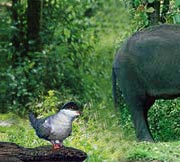 Main Regions: Karnataka, Tamilnadu, Kerala, Uttaranchal/Uttarakhand, Orissa & Assam
Main Regions: Karnataka, Tamilnadu, Kerala, Uttaranchal/Uttarakhand, Orissa & Assam Elephant Reserves: Periyar Wildlife Sanctuary, Bandipur and Nagarhole National Parks
India is a land where animals and plants are revered and enjoy a special status. Elephant is one such animal that is an integral part of our socio-cultural ethos. Be it the temples, religious processions, festivals or celebrations, you will find elephants everywhere. For thousands of years elephants have been a source of awe and wonder for human beings. The Indian Asian elephants are much smaller in size than the African elephants. The length or absence of tusks is another difference.
The height of an average male elephant is around 240-300cm while they may weigh anywhere between 3600 to 5000 kg. With large feet the elephant is able to distribute its enormous weight over a large surface area. The male elephants have huge tusks, which are actually incisor teeth made of ivory that can measure up to 5 feet in length. It is interesting to note that the elephant uses its tusks to dig for food, clear debris and carry heavy logs.
Physical Characterstics
Indian elephant (Elephas maximus indicus) is one of three subspecies/races of the Asian elephant (Elephas maximus). The other two subspecies of the Asian elephant being E. m. sumatranus (Sumatra) and E. m. maximus (Sri Lanka). The Indian elephant is larger and has longer front legs and a thinner body than the Asian elephant found in Thailand. Generally, the Asian elephant weighs between 3-5 tons. In contrast to this, the African elephant weighs between 4-7 tons.
Trunk
Elephants are endowed with versatile trunks, which they use for a variety of functions. The trunk has no bones or cartilage except for a tiny bit of cartilage at the tip of the trunk, which separates the nostrils. There is a single finger at the tip of the Asian elephants trunk whereas the African elephant has two fingers. Elephants do not use trunks like a straw to drink nstead they suck water into the trunk and later squirt it into their mouths.
Hearing and Sight
The ears of Asian elephants do not exceed the height of the neck whereas the African elephants do as they have large ears. Elephants have far superior hearing than humans and their large ears act as amplifiers. The sound of Elephants travel over many kilometers, which they use during stress, excitement and to relay sexual information. Elephants have have small eyes and poor eyesight that is why they can see clearly only up to about 10 m (30-40 feet). Under the shade, the eyesight of elephants tend to improve.
Teeth
Elephant does not have canine teeth but four high molars for grinding of food etc. These molars do not succeed one another vertically as they do in case of mammals but come in succession from behind, one tooth at a time. It is interesting to note that an elephant grows only six complete sets of these molars during its lifetime. A baby elephant usually has two or three cheek teeth in each jaw quadrant. As it grows older, new and bigger teeth form at the back of these, slowly pushing them forward.
Tusk
The tusk of the elephant, which is commonly classified as ivory, is in fact teeth (elongated upper incisors). These are modified incisors made up mostly of dentine (a bone like tissue found in many animals). Apart from elephants, the only other animal to have ivory teeth is walrus. Here, it is important to note that not all the male Asian elephants have tusks. In Sri Lanka only 7% of the male elephants are tuskers whereas in South India up to 90% elephants have tusks. In the female elephants, the tusks are either absent or rudimentary. The size of the male elephant tusk may sometimes go up to 1.8m, however they are usually much shorter as they are worn down due to work, foraging, digging or fighting.
| Facts on Elephant | General Characteristics | Indian Elephant Pictures |





